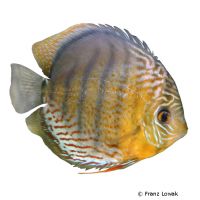Green Tefe Discus (Symphysodon aequifasciatus 'Green Tefe')
| Green Tefe Discus Symphysodon aequifasciatus 'Green Tefe' | |
|---|---|
| Name | Green Tefe Discus |
| Name Lat. | Symphysodon aequifasciatus 'Green Tefe' |
| Family | Cichlids |
| Family lat. | Cichlidae |
| Order | Cichlids |
| Order lat. | Cichliformes |
| Origin | Brazil |
| Habitat | Rivers, tributaries |
| Diet | Carnivore |
| pH | 5.0-7.5 |
| Behavior | Peaceful |
| Keeping | Pair, group |
| Care Level | Difficult |
| Reproduction | Substrate spawner |
| Breeding | Difficult |
| Life Span | 8-10 years |
| Protection | No |
| Metric Units | |
| Size | 15 cm |
| Temperature | 27-30 °C |
| Hardness | 1-10 °dH |
| Aquarium | ~ 350 l |
| US Units | |
| Size | 6" |
| Temperature | 81-86 °F |
| Hardness | 18-178 ppm |
| Aquarium | ~ 90 gal |
Distribution and habitat
The Green Tefe Discusfish is a site variety found in the Rio Tefe and its tributaries in Brazil. They live in sluggish flowing or stagnant waters, such as tributaries and lakes, rarely in the large rivers, where they often stay in groups in deep water, among roots, dead wood and stones.
Maintenance
The aquarium should have well structured planting, providing both shelter and swimming space, with roots as hiding places. A dark substrate covered with some foliage (sea almond leaves), subdued light (floating plants) and soft, slightly acidic water is ideal. No ammonia, ammonium and nitrite should be detectable, the nitrate value should not exceed 100 mg/l. To ensure the water quality and oxygen content, a filter and heater adapted to the aquarium size is required, as well as lighting for the species-appropriate day-night rhythm of the animals.
Diet
In nature they feed mainly on zooplankton and insect larvae. The food supply consists of live, frozen and dry food. For a balanced diet, feed once a day with a high-quality dry food for discus fish (flakes, granules, pellets) as well as daphnia, artemia, mysis, mosquito larvae, etc. (live or frozen).
It is recommended to feed small portions several times a day. Only feed as much as will be eaten within a few minutes. A regular and varied diet promotes health and increases resistance.
Behaviour and compatibility
Discus fish are calm peaceful fish that only show pronounced territorial behavior during spawning season. They should be kept in pairs or in a group. Keeping multiple pairs or a group is only recommended in a large, richly structured tank. They should only be socialized with other calm, peaceful and heat-loving fish. Basically, only compatible fish species with similar demands on water quality and water temperature should be socialized.
Sex dimorphism
Outside the spawning season the sexes are hardly distinguishable. With some experience, the sexes can be determined during mating by the shape of the genital papilla, which is pointed in the male and round in the female.
Reproduction and breeding
After a harmonizing pair is found, the female usually spawns on a root. The larvae feed for several days on a skin secretion secreted by the parents. Together they care for and guard the clutch and look after their offspring for a long time
Young fish must be fed several times a day with special rearing food (Artemia nauplii). In community tanks breeding is hardly possible, because the young fish are easy prey.
Important
In the large distribution area of the discus fish there are some site variants, which differ in coloration and pattern.
Discus fish are very shy and skittish and need many shelters and hiding places to feel comfortable. They make special demands on water quality and water values. Foliage (sea almond tree, oak, etc.) enriches the water with humic substances, naturally lowers the pH and strengthens their immune defenses
Due to their body height, the aquarium should be at least 50 cm high.
The well-being of the fish should be checked regularly. The temperature should be checked daily, the pH, hardness and nitrate value at least every 14 days. Regular partial water changes are recommended, even if the pollutant level has not yet reached the upper limit. Sudden changes in water quality should be avoided. Newly introduced fish must be accustomed slowly to the water in the aquarium
Further literature can be found in your pet store.
References
Text: Werner Winter; Image: Franz Lowak
Source: BMEL (1998): Tierschutzgutachten - Haltung von Zierfischen (Süßwasser); RIEHL & BAENSCH (2006): Aquarien Atlas Bd. 1, Mergus Verlag; ENGELMANN (2005): Zootierhaltung - Tiere in menschlicher Obhut: Fische, Verlag Harri Deutsch
- Gemäß § 21 Abs. 5 Tierschutzgesetz idgF
